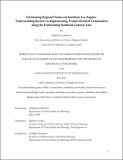| dc.description.abstract | The first 14.5-mile phase of the Southeast Gateway Line (SEGL), a planned light rail project through Southeast Los Angeles and the Gateway Cities region, is expected to be completed by 2035. The rail line aims to improve transit access while being complemented by a regional planning framework and station area planning that seeks to promote transit-oriented communities around station areas and drive equitable community development along the corridor. However, it remains uncertain whether the frameworks and governing bodies responsible for implementing the rail project, including the Los Angeles County Metropolitan Transportation Authority (LA Metro), the Gateway Cities Council of Governments (GCCOG), and cities along the corridor, will effectively align the transit investment with these land use and development goals.
Given these uncertainties, this thesis focuses on the Southeast Los Angeles (SELA) subregion, where a history of structural challenges underscores both the urgency and the complexity of realizing visions for transit-oriented communities tied to the forthcoming rail investment. Drawing on semi-structured interviews with LA Metro and GCCOG staff, along with officials and staff from cities hosting future stations, this research explores the emerging political, economic, and structural barriers to implementing transit-oriented land use around two future SEGL stations: Florence/Salt Lake Station in Huntington Park and Firestone Station in South Gate, both stations of which have multi-jurisdictional spheres of influence. This thesis also proposes a collaborative framework that encourages SELA stakeholders to engage in incremental, low-stakes planning and establish accountability mechanisms before the rail arrives, laying the foundation for sustained stewardship over the vision of transit-oriented communities and broader equitable community development goals throughout the rail's lifespan. | |
